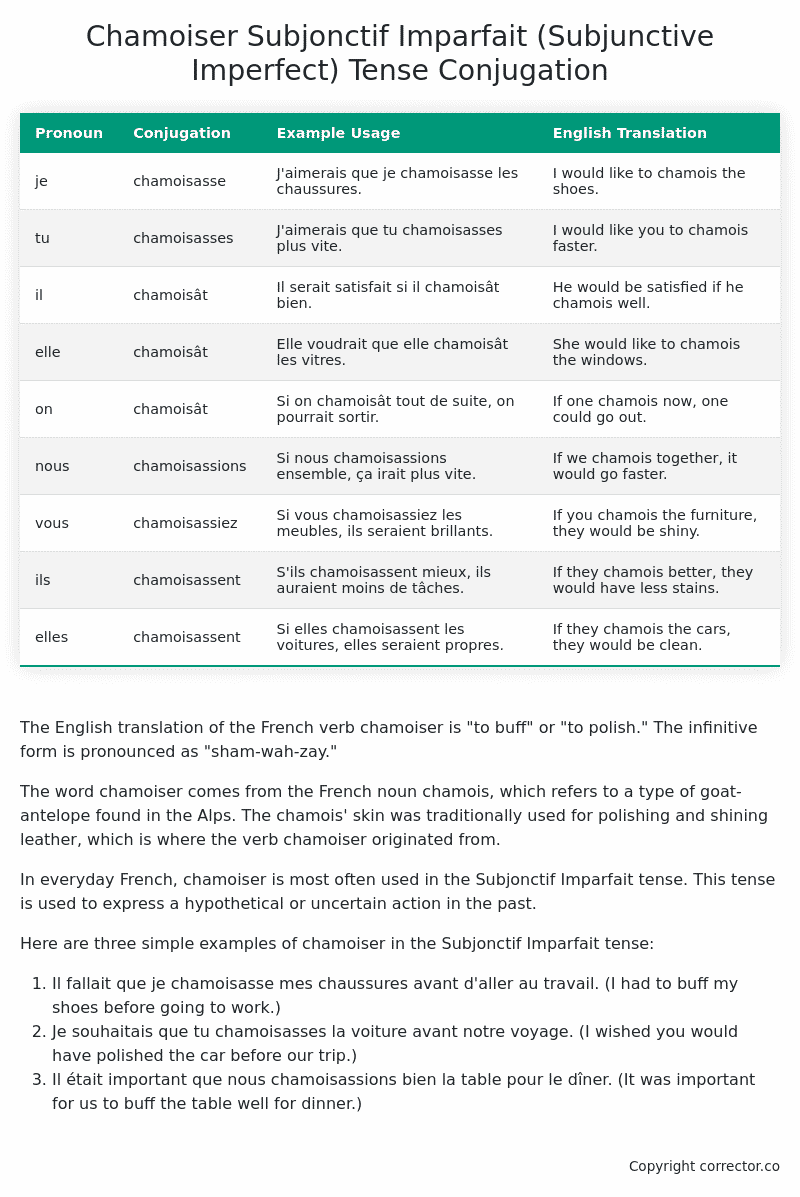Subjonctif Imparfait (Subjunctive Imperfect) Tense Conjugation of the French Verb chamoiser
Introduction to the verb chamoiser
The English translation of the French verb chamoiser is “to buff” or “to polish.” The infinitive form is pronounced as “sham-wah-zay.”
The word chamoiser comes from the French noun chamois, which refers to a type of goat-antelope found in the Alps. The chamois’ skin was traditionally used for polishing and shining leather, which is where the verb chamoiser originated from.
In everyday French, chamoiser is most often used in the Subjonctif Imparfait tense. This tense is used to express a hypothetical or uncertain action in the past.
Here are three simple examples of chamoiser in the Subjonctif Imparfait tense:
- Il fallait que je chamoisasse mes chaussures avant d’aller au travail. (I had to buff my shoes before going to work.)
- Je souhaitais que tu chamoisasses la voiture avant notre voyage. (I wished you would have polished the car before our trip.)
- Il était important que nous chamoisassions bien la table pour le dîner. (It was important for us to buff the table well for dinner.)
Table of the Subjonctif Imparfait (Subjunctive Imperfect) Tense Conjugation of chamoiser
| Pronoun | Conjugation | Example Usage | English Translation |
|---|---|---|---|
| je | chamoisasse | J’aimerais que je chamoisasse les chaussures. | I would like to chamois the shoes. |
| tu | chamoisasses | J’aimerais que tu chamoisasses plus vite. | I would like you to chamois faster. |
| il | chamoisât | Il serait satisfait si il chamoisât bien. | He would be satisfied if he chamois well. |
| elle | chamoisât | Elle voudrait que elle chamoisât les vitres. | She would like to chamois the windows. |
| on | chamoisât | Si on chamoisât tout de suite, on pourrait sortir. | If one chamois now, one could go out. |
| nous | chamoisassions | Si nous chamoisassions ensemble, ça irait plus vite. | If we chamois together, it would go faster. |
| vous | chamoisassiez | Si vous chamoisassiez les meubles, ils seraient brillants. | If you chamois the furniture, they would be shiny. |
| ils | chamoisassent | S’ils chamoisassent mieux, ils auraient moins de tâches. | If they chamois better, they would have less stains. |
| elles | chamoisassent | Si elles chamoisassent les voitures, elles seraient propres. | If they chamois the cars, they would be clean. |
Other Conjugations for Chamoiser.
Le Present (Present Tense) Conjugation of the French Verb chamoiser
Imparfait (Imperfect) Tense Conjugation of the French Verb chamoiser
Passé Simple (Simple Past) Tense Conjugation of the French Verb chamoiser
Passé Composé (Present Perfect) Tense Conjugation of the French Verb chamoiser
Futur Simple (Simple Future) Tense Conjugation of the French Verb chamoiser
Futur Proche (Near Future) Tense Conjugation of the French Verb chamoiser
Plus-que-parfait (Pluperfect) Tense Conjugation of the French Verb chamoiser
Passé Antérieur (Past Anterior) Tense Conjugation of the French Verb chamoiser
Futur Antérieur (Future Anterior) Tense Conjugation of the French Verb chamoiser
Subjonctif Présent (Subjunctive Present) Tense Conjugation of the French Verb chamoiser
Subjonctif Passé (Subjunctive Past) Tense Conjugation of the French Verb chamoiser
Subjonctif Imparfait (Subjunctive Imperfect) Tense Conjugation of the French Verb chamoiser (this article)
Subjonctif Plus-que-parfait (Subjunctive Pluperfect) Tense Conjugation of the French Verb chamoiser
Conditionnel Présent (Conditional Present) Tense Conjugation of the French Verb chamoiser
Conditionnel Passé (Conditional Past) Tense Conjugation of the French Verb chamoiser
L’impératif Présent (Imperative Present) Tense Conjugation of the French Verb chamoiser
L’infinitif Présent (Infinitive Present) Tense Conjugation of the French Verb chamoiser
Struggling with French verbs or the language in general? Why not use our free French Grammar Checker – no registration required!
Get a FREE Download Study Sheet of this Conjugation 🔥
Simply right click the image below, click “save image” and get your free reference for the chamoiser Subjonctif Imparfait tense conjugation!

Chamoiser – About the French Subjonctif Imparfait (Subjunctive Imperfect) Tense
Formation
Common Everyday Usage Patterns
Interactions with Other Tenses
Subjonctif Présent
Indicatif Passé Composé
Conditional
Conditional Perfect
Summary
I hope you enjoyed this article on the verb chamoiser. Still in a learning mood? Check out another TOTALLY random French verb conjugation!


